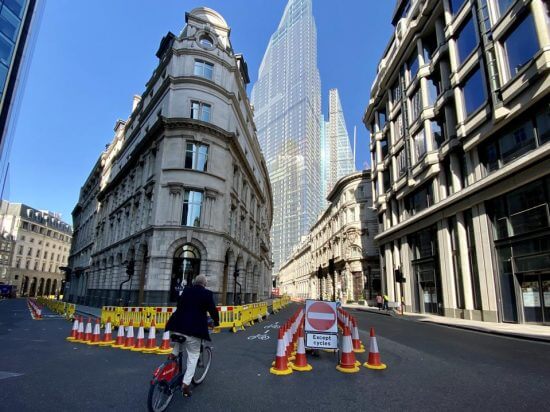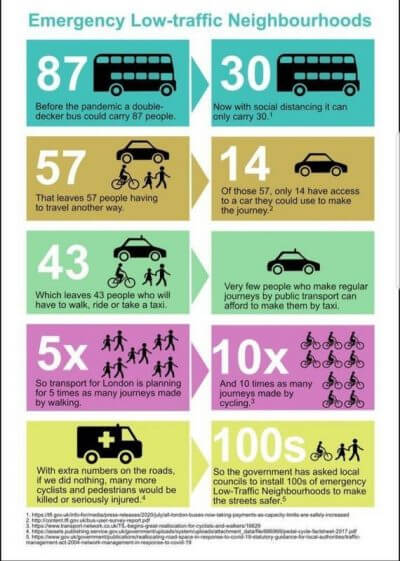“You never change things by fighting the existing reality. To change something, build a new model that makes the existing model obsolete.”

Today I want to use the example of shifting journeys in London away from private motor vehicle use to cycling and pedestrians to illustrate the opportunities and challenges inherent in human behaviour, as illustrated by this quote:
“You never change things by fighting the existing reality.
Buckminster Fuller
To change something, build a new model that makes the existing model obsolete.”
As a society we are gradually recognising the need for radical change in how we look at transportation, driven by the climate crisis. As Kathryn Sheridan pointed noted on a recent #WhatComesNext.Live show, what comes next is “we fry”. Incremental change isn’t enough, yet change has been incremental over the last decade as the modern world is so wedded to the car.
In London, the pandemic has forced rapid acceleration of this shift in transportation and due to necessity. Before the pandemic and lockdown London was still a city with massive amounts of private cars driving in and through it. As a resident of the centre of London, it was such a pleasure to breathe cleaner air and have more quiet during lockdown, but what comes next now we seek for people to go back to something close to normal, including travelling to work and otherwise around the city?
What comes next when we need to not just make incremental changes, but to “make the existing model obsolete”?
First, due to the need for social distancing, public transport in London simply cannot transport anywhere near the same number of people to work anymore, so a big part of what comes next is a radical shift towards more journeys being done by cycling and walking. This infographic clearly illustrates both the challenge and the huge opportunity.

London needs 5x more journeys to be made by walking and 10x more journeys by cycling.
This is such a radical need that we do indeed need to “make the existing model obsolete”
So, what is happening on the ground here in London?
Well, the picture at the top of this post (and the article linked with it) shows that in the City of London, they are radically shifting more towards eliminating vehicle traffic in the “square mile”. Of course, due to the unique nature of “the City”, it is not truly a “one person one vote” democracy, so they can move fast.
Now, outside of the City, each London borough is, working with (but not reporting to) the Mayor’s office, looking to move as fast as they can towards changing towards more, yet of course they are lead by elected politicians, so they are moving fast by their standards, but always with an eye on the next election.
So, noting the political element, now factor in that, as change is beginning to happen, resistance is present, particularly in areas not in the very centre of London (where car use is already low, often due to traffic congestion being so high that it is normally quicker to get around on the tube or bus than a car anyway!).
As an example, this week I allowed myself to engage with the maelstrom that is an online neighbourhood community site, where a very active discussion was going on about new “LTNs” (Low Traffic Neighbourhoods), with many furious car owners in the next ring out from the centre (Zone 2 and 3 of the London transport map) complaining about how it is suddenly now harder to use a car to get around.
These LTNs are being put in, as per the infographic, all over London, with residential roads being closed to prevent commuters and other motorists “rat running” to avoid main roads that are, yes, also now more congested as cycling superhighway infrastructure has been augmented in recent months to favour cyclists more. Yes, this is making car journeys slower and cycling and walking much, much easier. Oh, and I do now own a car in London as well as using public transport and cycling, so I have first hand experience of all of this.
Back to the online converations and the angry motorist. In brief, their argument starts out at the level of “but closing these roads makes traffic intolerable”, but underneath it all is that they are retaining belief that car use is not only inevitable, but a right.
In engaging with this online conversation, I attempted to engage at the level of asking a question not of each individual, but at a societal level, of “why does anyone need a car?”, in other words, asking the fundamental question of how we get around and how our individual choices impact the collective of society.
Yes, I fully understand and recognise that some do need cars for various reasons, but, for the reasons stated above, we as humanity must act on reducing private vehicle use (“what comes next is we fry”, remember?) and, more immediately, London must move far more journeys to cyclists and pedestrians. The need is real and present.
Now, the City of London Corporation is moving fast, perhaps as they are not a conventional democracy. Beyond “the City”, things are moving more slowly, but perhaps this is not the time, perhaps this is the time for radical change, for brave leadership to give the people what they need, even if it not what they (yet) know they need.
I leave you again with the Buckminster Fuller quote, then with two famous quotes from leaders who gave us two of the greatest innovations of the last century, the iPhone and, yes, the car.
“You never change things by fighting the existing reality.
Buckminster Fuller
To change something, build a new model that makes the existing model obsolete.”
“If I had asked people what they wanted, they would have said faster horses.”
Henry Ford
“It’s really hard to design products by focus groups. A lot of times, people don’t know what they want until you show it to them.”
Steve Jobs
